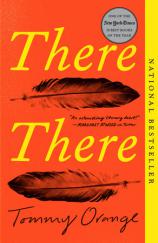There There
Review
There There
Near the beginning of Tommy Orange’s debut novel, a character named Dene Oxendene --- probably the closest thing to a stand-in for the author himself --- explains the motivation behind the documentary film project for which he is seeking grant funding: “I want to bring something new to the vision of the Native experience as it’s seen on the screen. We haven’t seen the Urban Indian story. What we’ve seen is full of the kinds of stereotypes that are the reason no one is interested in the Native story in general, it’s too sad, so sad it can’t even be entertaining…” One could imagine that Orange himself had a similar mission in mind as he set out to tell the stories of more than a dozen of those Urban Indians in THERE THERE.
These intersecting stories --- primarily set in Oakland, California (the novel gets its title from a Radiohead song and from Gertrude Stein’s infamous quote about Oakland that “there is no there there”) --- present a rich, varied and, yes, often entertaining portrait of the complexity of contemporary Native life. It could be argued that Orange --- with his technique of using multiple narrators --- is offering a 21st-century urban version of the kind of groundbreaking fiction Louise Erdrich wrote about reservation life in LOVE MEDICINE and elsewhere.
"These intersecting stories...present a rich, varied and, yes, often entertaining portrait of the complexity of contemporary Native life."
Many of the book’s short, well-developed chapters could stand on their own, but this is most definitely a novel, as all the plots propel readers toward a groundbreaking powwow at the Oakland Coliseum --- and toward the threat of violence there. Along the way, Orange tells the story of more than a dozen characters. In addition to Dene Oxendene (who sets up a Story Corps–style storytelling booth at the powwow), there’s Opal Viola Victoria Bear Shield, who became cynical about activism and Native identity after being compelled as a child to participate in the Native occupation of Alcatraz Island in 1970; there’s Opal’s sister, Jacquie Red Feather, whose lifelong struggle with alcoholism led her to become a substance abuse counselor; there’s Tony Loneman, whose fetal alcohol syndrome and resulting intellectual impairments make him vulnerable to the ominous intentions of other young men; and, most poignantly, there’s Opal’s grandson, Orvil, who longs to reclaim his Native identity by participating as a dancer at the powwow.
In addition to these and other stories, Orange includes a prologue and an interlude, both of which provide historical and social context and introduce readers to the complicated issues undergirding his characters’ stories and lives. These include the question of what it means to be a “real Indian” and the complicated question of blood: Who gets to claim Native identity, and who wants to? The Native people whose stories Orange tells are not painted as victims or as stereotypes or as poster children for the popular idea of resiliency, though they all wrestle in different ways with the marginalization of their communities and the invisibility of their stories.
Again and again, Orange returns to the idea of the vitality of narrating one’s own story and of listening to others’, whether in a storytelling booth, at a communal event like a powwow, or in the pages of novels like this one: “The wound that was made when white people came and took all that they took has never healed,” Orange writes. “An unattended wound gets infected. Becomes a new kind of wound like the history of what actually happened became a new kind [of] history. All these stories that we haven’t been telling all this time, that we haven’t been listening to, are just part of what we need to heal.”
Reviewed by Norah Piehl on June 8, 2018
There There
- Publication Date: May 7, 2019
- Genres: Fiction
- Paperback: 304 pages
- Publisher: Vintage
- ISBN-10: 0525436146
- ISBN-13: 9780525436140




